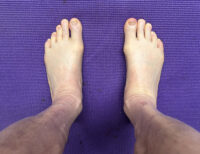The fever and body aches, the coughing, sneezing and general malaise. That’s right, it’s the H1N1 virus and it’s currently running around right here in Sonoma. More commonly referred to as swine flu, the virus has reared its ugly head in the Valley, most recently bringing two children under its vicious grip. According to Dr. Charles De Torres of Sonoma Plaza Pediatrics, the virus has actually been here for quite a while.
“We’ve seen other cases over the course of the past couple months. People really need to be aware that the virus is out there and take precautionary measures to stay healthy,” said De Torres.
De Torres can’t stress enough the importance of hand washing as one of those measures. Also, staying home when sick. “Children who are ill should not attend school or day care, adults should not go to work. And anyone with the virus or symptoms should avoid contact with others as much as possible,” said De Torres.
To help prevent the spread of H1N1, De Torres recommends using disinfecting wipes to clean hard surfaces on which the virus can live for two to five hours. These include computer keyboards, children’s toys, doorknobs and shopping cart handles. It should be noted that on porous substances, the virus can live up to one week.
Additionally, De Torres said that people with the virus remain contagious up to seven days from their first symptoms. Children may be contagious longer. According to the Centers for Disease Control and Prevention, in the U.S. the number of Americans stricken with H1N1 could reach 20 to 40 percent of the population over the next two years.
To combat the spread of the virus, the two-dose H1N1 vaccine is currently in production and will be administered free of charge beginning in mid-October (be aware that some providers may charge for an office visit – ask your doctor for details). The target population for the vaccine is as follows: pregnant women or those who live with or provide care for infants less than six months old; children six months to 24-years-old; and individuals 25 to 64 years old with a medical condition that puts them at a higher risk of flu-related complications.
De Torres also recommends that people get a regular flu shot. “We need to come together and be smart about this virus. Wash your hands, use sanitary wipes and disinfectant. Stay home when you’re sick.”
The symptoms of H1N1 flu are similar to those of regular seasonal flu. Information to parents includes the following:
• Teach children to wash their hands often with soap and water or an alcohol-based hand rub. You can set a good example by doing this yourself.
• Teach children not to share personal items like drinks, food or unwashed utensils, and to cover their coughs and sneezes with tissues. They should cover up their coughs or sneezes using the elbow, arm or sleeve instead of the hand when a tissue is unavailable.
• Know the signs and symptoms of the flu. Symptoms of the flu include fever (above 100°F, 37.8°C), cough, sore throat, a runny or stuffy nose, body aches, headache, and feeling very tired. Some people may also vomit or have diarrhea. Children or family members at high risk for complications of the flu, including pregnant women, those with asthma, diabetes, compromised immune systems or neuromuscular diseases should call their health care provider as soon as possible if they become ill to determine if treatment with antiviral medications is needed.
• Keep sick children at home for at least 24 hours after they no longer have fever or do not have signs of fever, without using fever-reducing medication such as Tylenol or Advil. Keeping children with a fever at home will reduce the number of people who may get infected.
• Do not send children to school if they are sick. Any children who are determined to be sick while at school will be sent home.
• Vaccinate your child for both the seasonal flu and H1N1 flu when the vaccine becomes available this fall.
If the flu becomes more severe in your school or around the county, additional steps that may be taken to prevent the spread of the flu include:
• Conducting active fever and flu symptom screening of students and staff as they arrive at school.
• Making changes to increase the space between people such as moving desks farther apart and postponing class trips.
• Increasing the dismissal period for students and staff from school to at least seven days if they become sick.
• Closing schools if the situation becomes serious enough that the public health officer authorizes such action.
For more information about the flu, visit the Sonoma County Public Health Web site sonoma-county.org/H1N1, call the Public Health Information Line at 707.565.4477 or visit the Center for Disease Control and Prevention at www.cdc.gov.




